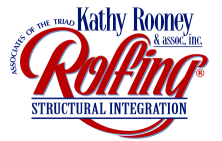Art of Well Being Article
Several years ago I was at a sales leads meeting, the kind where everyone gets ten seconds to talk about their business. As it went around the circle I was thinking about how to describe Rolfing® structural integration in ten seconds. Then someone said he sold a very sophisticated physical therapy machine that had such advanced computer chips in it that you could attach the patient to it and leave them unattended, thus making lots of money because you wouldn’t have to hire anyone to stay with the patient.
When it was my turn I said “I sell the most advanced way to work on a human structure. I have the most sophisticated sensing devices on the planet attached to the world’s most sophisticated computer: human fingers attached to a human brain.” Everybody laughed. But if you are looking for the best body therapy on the planet, start your search with hands on work.
When trained hands touch a body they can feel fascial lines of connection reaching throughout the entire body. As a Rolfing® practitioner when I make contact with these lines I am imputing energy and information which reverberates through the system and echoes back into my hands. The work provides an enormous feedback loop on what is going on in the client’s body and tissues, where the restrictions are and when and how they release. Interpreting this information into a coherent treatment is the goal of each Rolfing® session
Every health practitioner has a model of what a body is like. In Rolfing® our model has to do with how the body is functioning within the gravitational field. Everyone is “balanced” if they aren’t laid out on the floor. The question is how efficiently are you balanced? The hallmarks of an efficiently balanced structure are energy, resilience, grace and ease.
For years I wondered what a medical physician’s main model was. I finally came to the conclusion the medical profession sees the body as a big bag of organs and bones with a viral/bacterial load. The bones are broken or they’re not, the organs are functioning or they’re not and the bacterial/viral load is under control or it’s not. It explained a lot of things my clients had told me over the years.
Then one day I thought, what do I see when a client comes into my office? So as much as I hate to admit it, my model essentially is that the body is a big bag of connective tissue that’s shortened and distorted by old traumas. The shortening and distortion causes the bones to move in aberrant, inefficient patterns. This deprives the joints and organs of the space they need to function well. That’s why an elbow problem can be caused by a wrist problem or why a low back dysfunction can generate a knee problem. It is all connected.
Impact injuries are physical traumas that compress and disorganize the body. They include automobile accidents, falls, and collisions like the ones that occur playing football. If the relationship between structures is compromised by an impact injury, over time the connective tissue shortens to accommodate the new shape, which is the compressed shape resulting from the impact injury. Your amazing body will compensate for the change in shape, but each compensation leaves you with a little less optimal functioning than before. Even after an injury heals, the compensation remains.
Over time the ability to compensate becomes problematic. There is no automatic feedback to reverse the compensation once healing has occurred. As soon as the body/mind generates a compensation, it’s over and done with. To the body/mind if you are not hurting right now, you’re OK. That’s why insurance adjustors will call you the day after an automobile accident to ask if you are alright. They know your compensations are working and that you cannot feel the full effects of your injuries. They record your answer or worse, offer you a check and ask you to sign a release, knowing that the full effect of the collision may not be felt by you for six to eight months. The correct answer to their question is, “It’s too soon to tell.”
After six to eight months, the compensation can become part of the problem. For example, if you are elevating your shoulder girdle because the seatbelt disorganized your thorax in a minor automobile accident you can develop neck, shoulder or elbow pain. So the compensation itself may become painful, in which case you’re hurting again and the body/mind is looking for another compensation to make the pain go away.
Eventually the body can not generate a new compensation that does not interfere with an older compensation from some prior injury. In the common vernacular this is called being over the hill and it happens around age 35. Your ability to adapt to the new stresses of your life is compromised by this inability to generate new highly functioning compensations. This is one of the reasons it seems that a relatively minor incident can cause a lot of pain.
One of the things that Rolfing® structural integration provides is increased adaptability. The amazing thing is how amenable to touch connective tissue is. Old compensations can be unwound and the body/mind can use the newly restored functionality in much of the same way as it did when it was years younger. We can erase old compensations that are no longer needed, thereby restoring you to a more vibrant and youthful condition.
Copyright 2009 Kathy Rooney
